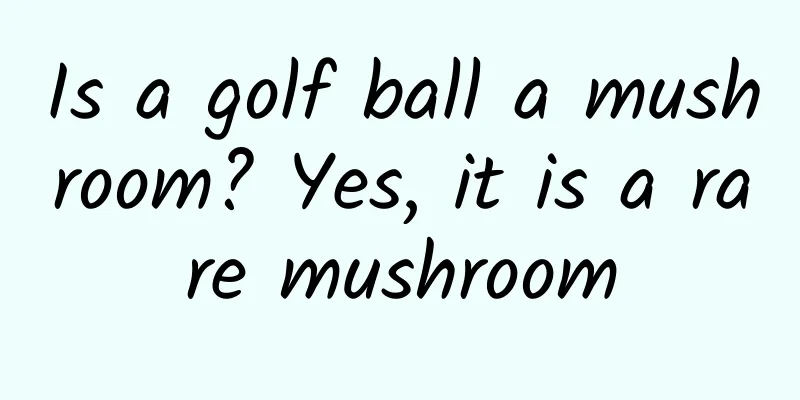Is a golf ball a mushroom? Yes, it is a rare mushroom

|
In Kew Gardens, located in the southwest suburbs of London, England, there is the world's largest and oldest fungal specimen museum . There are 1.25 million dried fungi specimens preserved here, which come from seven continents around the world, covering almost the entire fungal evolutionary tree. The oldest specimen can be traced back to the early 18th century. However, in this world-class specimen museum, some strange things were mixed in... Fungal specimen collection at Kew Gardens, UK | RBG Kew "Rare mushrooms" have been treasured for 70 years Among this huge treasure trove of specimens, the rarest collection is a special "mushroom" - so far, only three specimens of this species have been preserved in the world . The specimens are shrunken balls with thick, leathery brown skin and a charred black interior. Tags show that this is an officially recognized species, with the Latin name "Golfballia ambusta." Officially recognized rare mushrooms|RBG Kew All this seems fine at first glance—but the problem is that these specimens are not real mushrooms at all. Not only are they not part of the fungus family, they are not even related to the biological kingdom as a whole . In fact, the Latin name labels have revealed the true identity of these unidentified spheres. Golfballia ambusta, this Latin translation into Chinese means: burnt golf ball . Three golf balls sneaked into the world's top specimen museum and existed there as rare species for 70 years. What on earth happened? All three golf balls in Kew's collection | RBG Kew Golf balls mixed into Kew Gardens In 1952, the mysterious golf ball "specimen" was mailed to Kew Gardens for the first time. No one knew where it came from, and there was no signature or letter attached to the mailed specimen. From the scribbled handwriting on the envelope, people only knew that it came from Lancashire in northern England. After that, similar "specimens" were delivered twice more. The second "specimen" appeared in 1962, it came from East Africa, and the third appeared in 1971. After the fire, the golf ball has changed a lot | RBG Kew The golf balls are charred beyond recognition, their brown outer skin shrunken and cracked, revealing a black rubber core that resembles some puffballs. Puffballs are a type of fungus. The puffball in the picture above has a mouth that releases spores, which looks a bit like a burnt and cracked golf ball. | Robert Solem Perhaps it was this resemblance that inspired the prank of anonymously mailing fake specimens. Mycologists join in on the joke The researchers seemed to have followed a procedure to carefully identify these "specimens". For example, they placed the "specimen" on a piece of white paper overnight, carefully removed it the next morning, and then carefully observed the fungal spores left on the paper. Of course, they did not find any traces of spores in this observation . Mycologists tried to collect spores from a "specimen" using a piece of white paper - but apparently, they were unsuccessful | RBG Kew The mycologists may have been deceived at first, but it’s certain that they soon discovered the flaw—but instead of throwing the fake specimens into the trash, they chose to continue the joke. In 1962, mycologist RWG Dennis took the hoax to a climax when he published an article in an academic journal, seriously introducing the burnt golf ball as a new species of fungus . Richard William George Dennis (RWG Dennis), British mycologist | cambridge.org The paper is titled "A Remarkable New Species of Phallus from Lancashire and East Africa." Dennis's writing seems serious, but it is full of hints. He frankly said that the specimen smelled like "heated rubber" and that its appearance was very similar to "small hard balls that people enjoy in certain activities." Of course, the most obvious hint is the name of the "new species of fungus": Dennis directly translated the burnt golf ball into Latin and named the specimen Golfballia ambusta. Some people believe that Dennis did this to challenge the academic standards at the time: if even a non-biological product could be easily identified as a new species, it would mean that the process for identifying new species was too lax . Will the “mischievous species” continue to exist? To this day, the Kew Mycological Museum still retains these three "mushroom specimens" that are actually golf balls. From a legal point of view, it is still an official collection . Most of the time they just lie quietly in the corner, but occasionally they will deceive the new generation of researchers who come to look up information, causing some brief confusion. Detail of a burnt golf ball | RBG Kew If they were removed from the collection, the confusion would have been avoided. However, these golf balls are also a testimony to an interesting historical event, and it would be hard to bear to throw them in the trash. Perhaps it would be best to remove them from the fungus collection and put them on display somewhere special. References [1]https://www.kew.org/read-and-watch/golf-ball-becomes-rare-fungus [2]https://twitter.com/curataceae/status/1087724590837710859 [3]https://www.environmentandsociety.org/arcadia/what-fungus-mycologys-dada-moment Author: Window Knocking Rain Editor: Little Towel, Mai Mai Title image source: RBG Kew |
>>: Building forest "grain depot" to make China's rice bowl more "abundant"
Recommend
Luckin Coffee brand promotion strategy!
In April 2019, Luckin Coffee launched four types ...
There is no suspense about the new Macbook Pro. You just need to save money to buy it.
More than 20 days ago, Apple’s press conference o...
How come the famous Nobel Prize was awarded to a football player?
“I was able to achieve some of my success (and wi...
The first batch of mass-produced models equipped with Doubao large models, smart Elf 5 is about to be released
Today, the new luxury intelligent pure electric c...
How to create popular content on Xiaohongshu?
As one of the social platforms, Xiaohongshu’s mis...
This article will show you the magical ocean temperature difference power generation
The ocean is the world's largest solar collec...
Latest research: Can you prevent dementia by eating? This healthy diet should be saved for your family
A recent study published by researchers from Newc...
China Automobile Dealers Association: A brief analysis of the used car market in December 2021 and the whole year
In 2021 , the automobile market is facing a compl...
NIO plans to issue 160 million American depositary shares at a price range of $6.25 to $8.25
According to foreign media reports, NIO submitted...
Users hate ads, and monetization has reached a bottleneck? That’s because you didn’t choose the right advertising format!
Nowadays, common and new forms of mobile advertis...
Is the effect of information flow advertising poor? You may need an operations plan!
Earlier, Coca-Cola officially introduced the posi...
When is Shanghai expected to be fully unsealed in 2022? When will it end and return to normal? Attached is the latest news on the epidemic!
The epidemic situation in Beijing and Shanghai in ...
National Love Teeth Day丨How far are we from dental implant freedom?
Jointly produced by: Sina News Photo and Data Roo...
Awesome! The Deep Blue G318 cuts the fuel consumption of hardcore cars in half. Who would say hardcore cars have high fuel consumption?
Since its debut at the beginning of this year, th...
Internet finance, how to quickly acquire a large number of real target users?
“Just like true love, you never need to chase aft...









